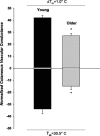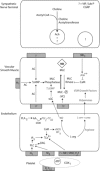Peripheral mechanisms of thermoregulatory control of skin blood flow in aged humans
- PMID: 20413421
- PMCID: PMC3774123
- DOI: 10.1152/japplphysiol.00338.2010
Peripheral mechanisms of thermoregulatory control of skin blood flow in aged humans
Abstract
Human skin blood flow is controlled via dual innervation from the sympathetic nervous system. Reflex cutaneous vasoconstriction and vasodilation are both impaired with primary aging, rendering the aged more vulnerable to hypothermia and cardiovascular complications from heat-related illness. Age-related alterations in the thermoregulatory control of skin blood flow occur at multiple points along the efferent arm of the reflex, including 1) diminished sympathetic outflow, 2) altered presynaptic neurotransmitter synthesis, 3) reduced vascular responsiveness, and 4) impairments in downstream (endothelial and vascular smooth muscle) second-messenger signaling. This mechanistic review highlights some of the recent findings in the area of aging and the thermoregulatory control of skin blood flow.
Figures



References
-
- Armstrong CG, Kenney WL. Effects of age and acclimation on responses to passive heat exposure. J Appl Physiol 75: 2162–2167, 1993 - PubMed
-
- Bailey SR, Eid AH, Mitra S, Flavahan S, Flavahan NA. Rho kinase mediates cold-induced constriction of cutaneous arteries: role of alpha2C-adrenoceptor translocation. Circ Res 94: 1367–1374, 2004 - PubMed
-
- Bailey SR, Mitra S, Flavahan S, Flavahan NA. Reactive oxygen species from smooth muscle mitochondria initiate cold-induced constriction of cutaneous arteries. Am J Physiol Heart Circ Physiol 289: H243–H250, 2005 - PubMed
-
- Berkowitz DE, White R, Li D, Minhas KM, Cernetich A, Kim S, Burke S, Shoukas AA, Nyhan D, Champion HC, Hare JM. Arginase reciprocally regulates nitric oxide synthase activity and contributes to endothelial dysfunction in aging blood vessels. Circulation 108: 2000–2006, 2003 - PubMed
Publication types
MeSH terms
Grants and funding
LinkOut - more resources
Full Text Sources
Medical

